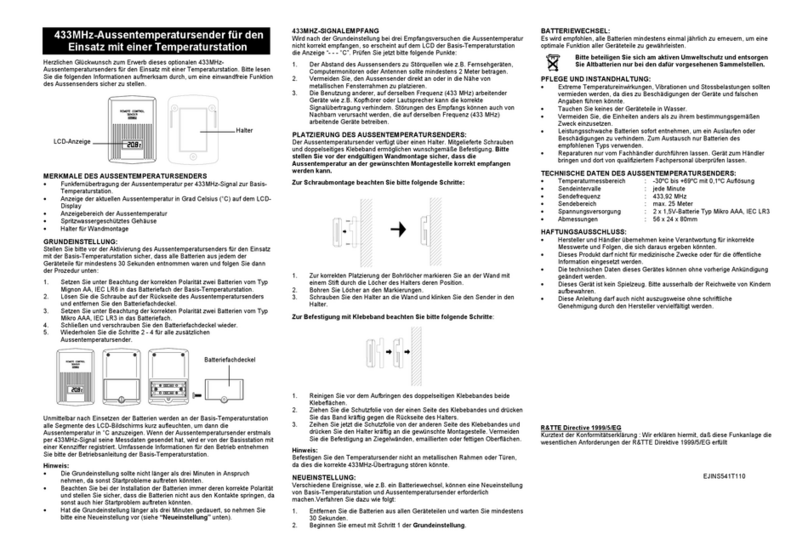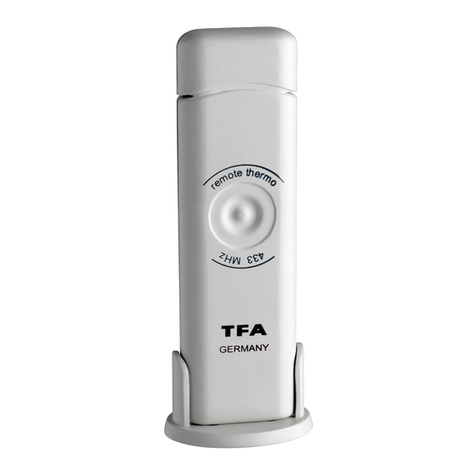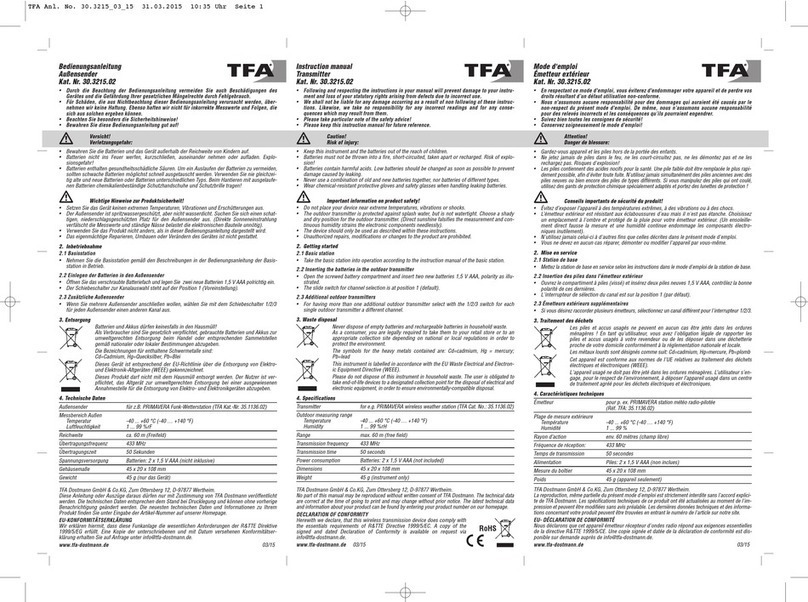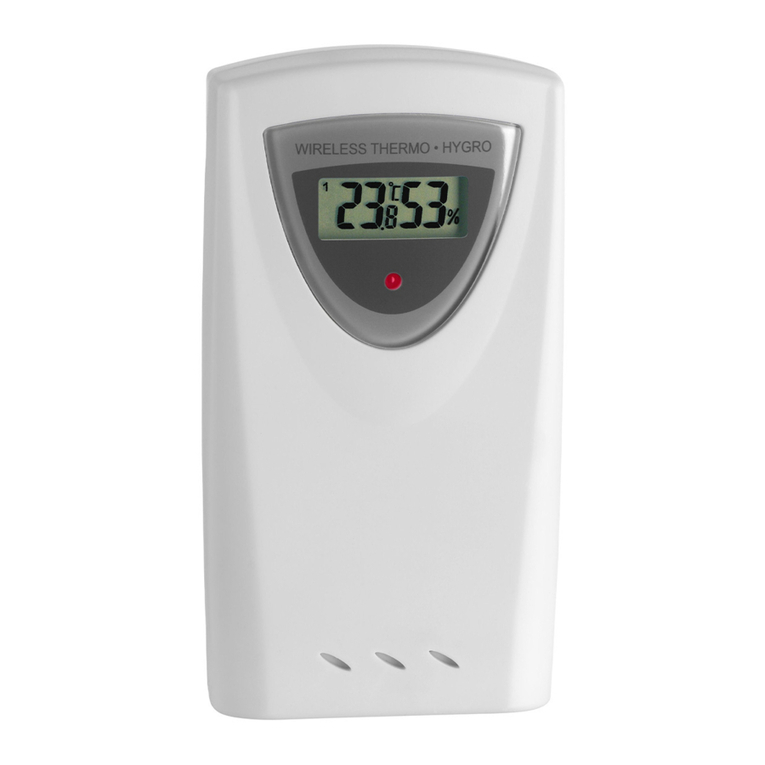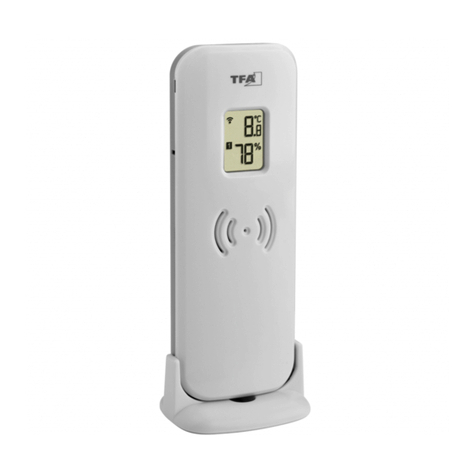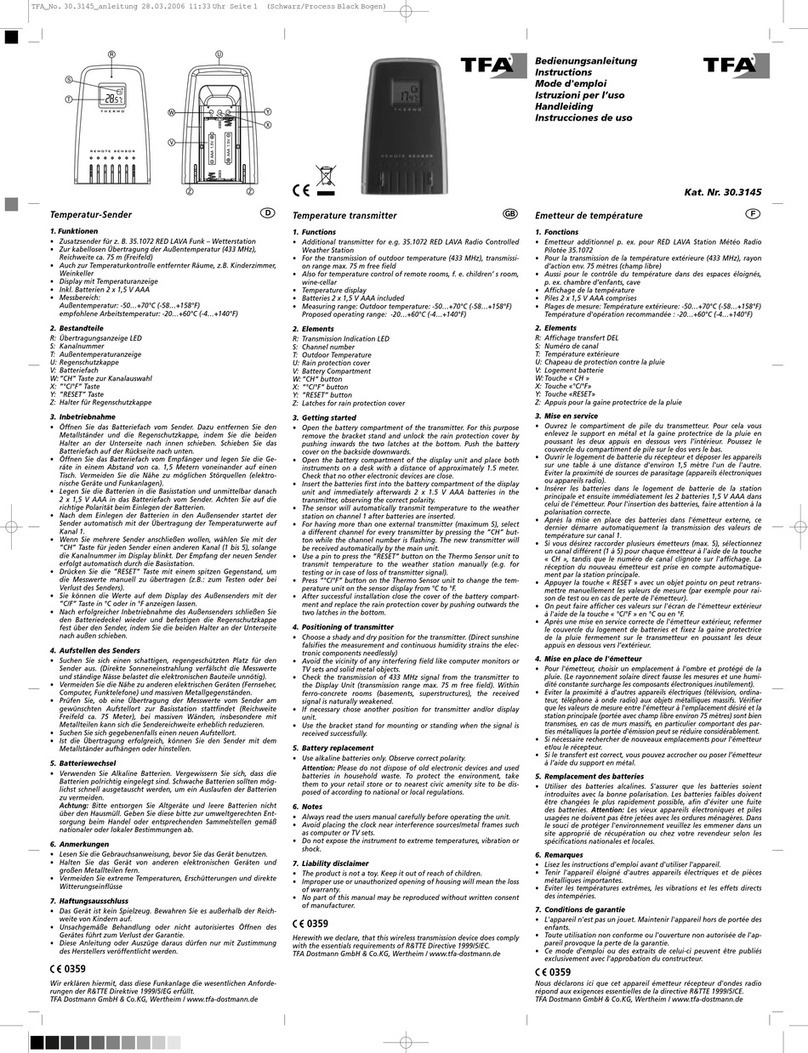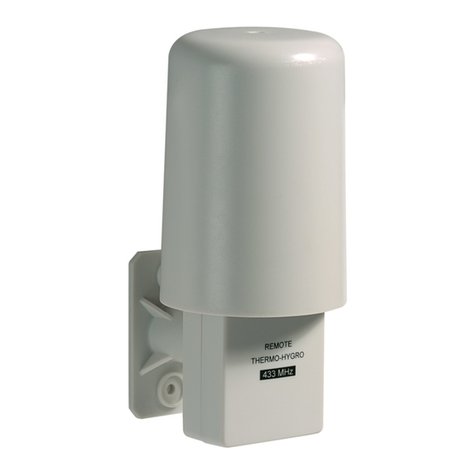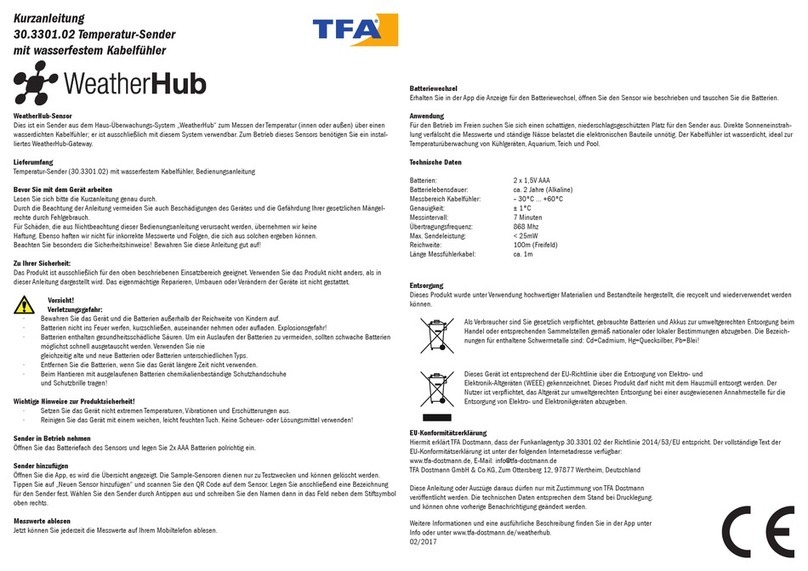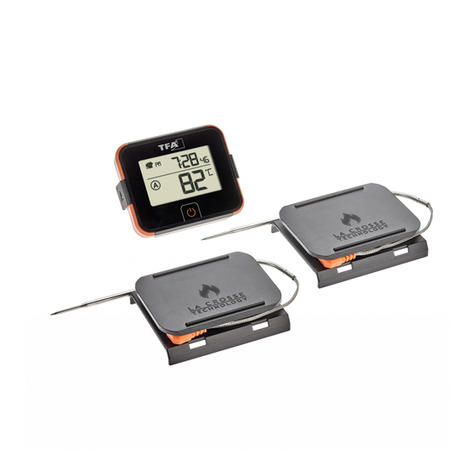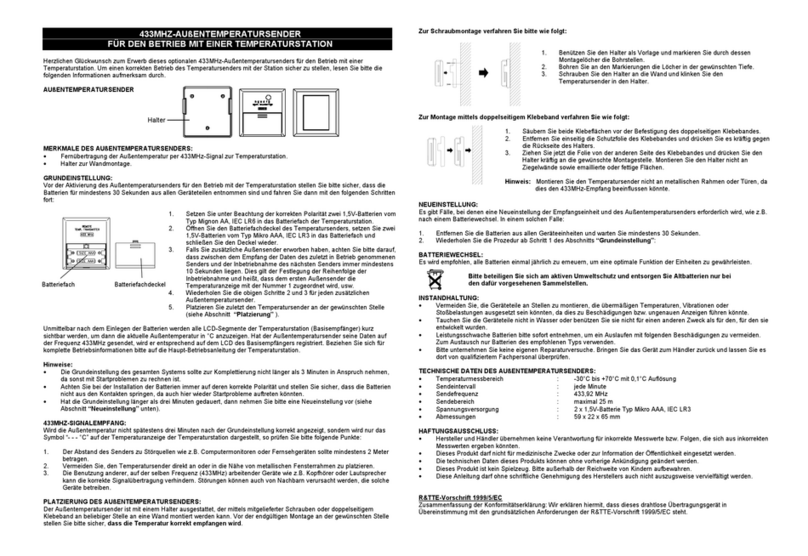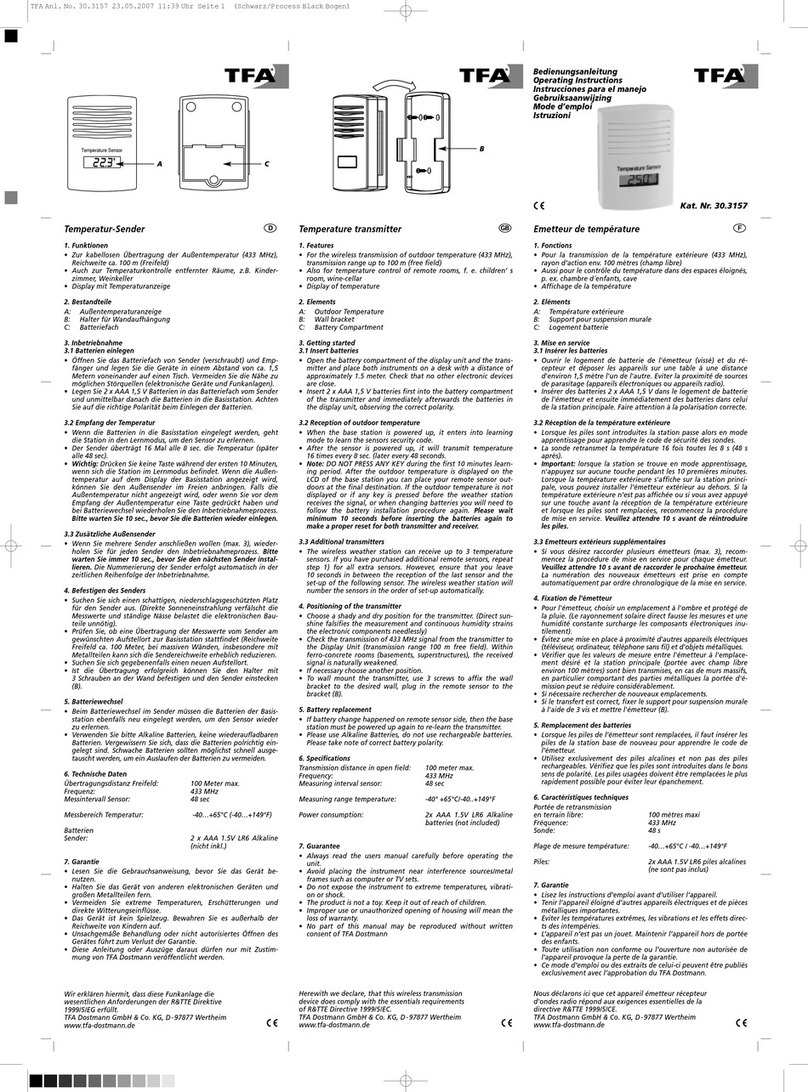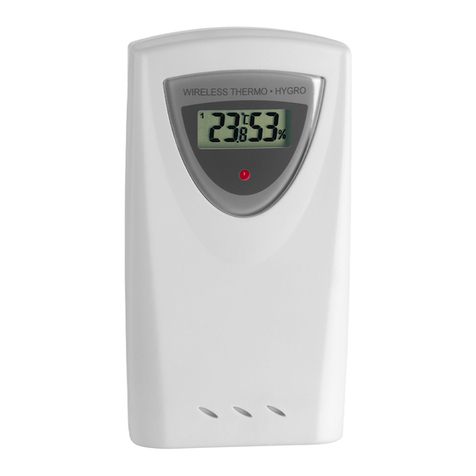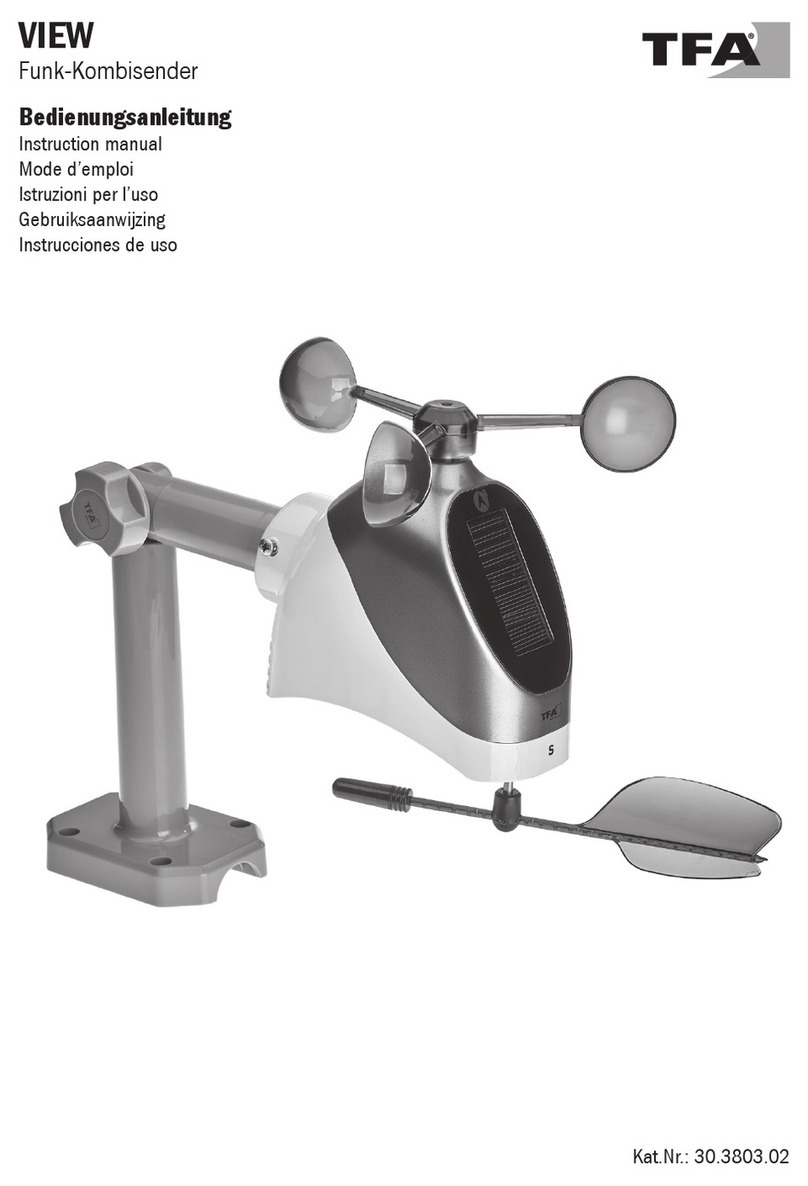Bedienungsanleitung
Instruction manual
Mode d'emploi
Transmitter – Temperature-humidity Emetteur – Température-humidité
• Check the transmission of the signal from the outdoor transmitter to the basic
unit (transmission range 75 m free field). Within ferro-concrete rooms (base-
ments, superstructures), the received signal is naturally weakened.
• If necessary choose another position for the outdoor transmitter and/or basic
unit.
• If the transmission is successfully, fix the outdoor transmitter by using a nail (not
included) on the wall or place it onto a flat surface.
6. Care and maintenance
• Clean the device with a soft damp cloth. Do not use solvents or scouring agents.
• Remove the batteries if you do not use the products for a lengthy period.
• Keep the instruments in a dry place.
6.1 Battery replacement
•Please note: When the batteries are changed, the contact between transmitter
and receiver must be restored – so always insert new batteries into both units or
start a manual transmitter search.
7. Waste disposal
Never dispose of empty batteries and rechargeable batteries in house-
hold waste.
As a consumer, you are legally required to take them to your retail store
or to an appropriate collection site depending on national or local regu-
lations in order to protect the environment.
The symbols for the heavy metals contained are:
Cd=cadmium, Hg=mercury, Pb=lead
This instrument is labelled in accordance with the EU Waste Electrical
and Electronic Equipment Directive (WEEE).
Please do not dispose of this instrument in household waste. The user
is obligated to take end-of-life devices to a designated collection point
for the disposal of electrical and electronic equipment, in order to
ensure environmentally-compatible disposal.
8. Specifications
Measuring range outdoor
Temperature: -40°C… +60 °C (-40°...+140 °F)
Resolution: 0.1 °C (0.2 °F)
Humidity: 20 %rH ... 99 %rH
Operating environment: -20 °C ...+60 °C (-4 °F…+140 °F)
Range: max. 75 m (free field)
Transmission frequency: 868 MHz
Maximum radio-frequency power: < 25 mW
Transmission time: 120 seconds
Power consumption: 2 x 1.5 V AA (Batteries not included)
Dimensions: 53 x 26 x 105 mm
Weight: 50 g (instrument only)
No part of this manual may be reproduced without written consent of TFA Dostmann. The tech-
nical data are correct at the time of going to print and may change without prior notice.
The latest technical data and information about your product can be found by entering your
product number on our homepage.
EU declaration of conformity
Hereby, TFA Dostmann declares that the radio equipment type 30.3196 is in compliance with
Directive 2014/53/EU.
The full text of the EU declaration of conformity is available at the following internet address:
www.tfa-dostmann.de
TFA Dostmann GmbH & Co.KG, Zum Ottersberg 12, D-97877 Wertheim, Germany 09/16
Nous vous remercions d'avoir choisi l'appareil de la Société TFA.
1. Avant d'utiliser l'appareil
•Lisez attentivement le mode d'emploi.
•En respectant ce mode d'emploi, vous éviterez d'endommager l'appareil et de
perdre vos droits résultant d'un défaut pour cause d'utilisation non-conforme.
•Nous n'assumons aucune responsabilité pour des dommages qui auraient été
causés par le non-respect du présent mode d'emploi. De même, nous n’assu-
mons aucune responsabilité pour des relevés incorrects et les conséquences
qu’ils pourraient engendrer.
•Suivez bien toutes les consignes de sécurité!
•Conservez soigneusement le mode d'emploi!
2. Aperçu du domaine d'utilisation et de tous les avantages de votre nouvel
appareil
• Émetteur à utiliser avec la station météo TFA 35.1122 + 35.1128
• Pour la transmission de la température et humidité extérieure (868 MHz), rayon
d’action env. 75 mètres (champ libre)
3. Pour votre sécurité
• L'appareil est destiné uniquement à l'utilisation décrite ci-dessus. Ne l'utilisez
jamais à d'autres fins que celles décrites dans le présent mode d'emploi.
• Vous ne devez en aucun cas démonter ou modifier l'appareil par vous-même.
Attention!
Danger de blessure:
• Gardez votre appareil et les piles hors de la portée des enfants.
• Ne jetez jamais les piles dans le feu, ne les court-circuitez pas, ne les démontez
pas et ne les rechargez pas. Risques d'explosion!
• Les piles contiennent des acides nocifs pour la santé. Une pile faible doit être
remplacée le plus rapidement possible, afin d'éviter une fuite. N’utilisez jamais
d'anciennes piles avec des piles neuves simultanément ou bien encore des piles
de types différents. Pour manipuler des piles qui ont coulé, utilisez des gants de
protection chimique spécialement adaptés et portez des lunettes de protection !
Conseils importants de sécurité du produit!
• Évitez d’exposer l’appareil à des températures extrêmes, à des vibrations ou à des
chocs.
• L’émetteur extérieur est résistant aux éclaboussures d'eau mais il n'est pas étan-
che. Choisissez un emplacement à l'ombre et protégé de la pluie pour votre émet-
teur.
4. Composants
Boîtier:
D 1: Lampe de signalisation à DEL
D 2: Suspension murale D 3: Compartiment des piles
Touches dans le compartiment des piles:
D 4: Touche RESET D 5: Touche CH
5. Mise en service
Insertion des piles:
• Déposer la station de base et émetteur sur une table á une distance d'environ 1,5
mètre l'un de l'autre. Eviter la proximité de sources de parasitage (appareils élec-
troniques ou appareils radio).
• Mettre la station de base en service selon les instructions dans le mode d'emploi
de la station de base.
• Insérez immédiatement après deux piles neuves 1,5 V AA dans le compartiment à
piles de l'émetteur extérieur. Assurez-vous que les piles sont insérées selon la
bonne polarité.
5.1 Émetteur extérieur
• Après la mise en service de l'émetteur extérieur ce dernier démarre automatique-
ment la transmission des valeurs extérieures sur canal 1.
• Si vous désirez raccorder plusieurs émetteurs, sélectionnez un canal différent
pour chaque émetteur à l'aide de la touche CH (à gauche) dans le compartiment à
piles de l’émetteur, tandis que la lampe de signalisation à DEL clignote (après la
mise en service de l’émetteur). Appuyez une fois pour canal 2 et deux fois pour
canal 3 La lampe de signalisation à DEL clignote une fois pour canal 1 et deux
fois pour canal 2 et trois fois pour canal 3.
Emetteur – Température-humidité
5.2 Mise en place et fixation de l’émetteur
• Choisissez un emplacement à l'ombre et protégé de la pluie pour votre émetteur.
(L'exposition directe au soleil falsifie la mesure et une humidité continue endom-
mage les composants électroniques inutilement).
• Vérifiez que les valeurs de mesure entre l'émetteur et la station principale (portée
avec champ libre d'environ 75 mètres) sont bien transmises de l'endroit choisi.
En cas de murs massifs, en particulier comportant des parties métalliques la por-
tée d'émission peut se trouver réduite considérablement.
•
Si nécessaire cherchez de nouveaux emplacements pour l'émetteur et/ou le récepteur.
• Si le transfert est correct fixez l'émetteur à la suspension murale à l'aide d’une vis
ou mettez en place sur une surface plate.
6. Entretien et maintenance
• Pour le nettoyage de votre appareil, utilisez un chiffon doux et humide. N’utilisez
aucun agent solvant abrasif!
• Enlevez les piles, si vous n'utilisez pas votre appareil pendant une durée prolongée.
• Conservez-le dans un endroit sec.
6.1 Remplacement des piles
•Attention: Il faut rétablir le contact entre l'émetteur et le récepteur après le rem-
placement des piles - Il faut donc toujours remplacer les piles dans les deux
appareils ou bien lancer la recherche manuellement.
7. Traitement des déchets
Les piles et accus usagés ne peuvent en aucun cas être jetés dans les
ordures ménagères ! En tant qu'utilisateur, vous avez l'obligation léga-
le de rapporter les piles et accus usagés à votre revendeur ou de les
déposez dans une déchetterie proche de votre domicile conformément
à la réglementation nationale et locale.
Les métaux lourds sont désignés comme suit:
Cd=cadmium, Hg=mercure, Pb=plomb
Cet appareil est conforme aux normes de l'UE relatives au traitement
des déchets électriques et électroniques (WEEE).
L'appareil usagé ne doit pas être jeté dans les ordures ménagères.
L’utilisateur s’engage, pour le respect de l’environnement, à déposer
l’appareil usagé dans un centre de traitement agréé pour les déchets
électriques et électroniques.
8. Caractéristiques techniques
Plage de mesure extérieure
Température: -40°C… +60 °C (-40°...+140 °F)
Résolution: 0,1 °C (0,2 °F)
Humidité: 20 %rH ... 99 %rH
Zone de travail: -20 …60 °C (-4 … 140 °F)
Rayon d’action: env. 75 mètres (champ libre)
Fréquence de réception: 868 MHz
Puissance de radiofréquence
maximale transmise: < 25 mW
Le temps de transmission: 120 secondes
Alimentation: 2 x 1,5 V AA (piles non incluses)
Mesure de boîtier: 53 x 26 x 105 mm
Poids: 50 g (appareil seulement)
La reproduction, même partielle du présent mode d'emploi est strictement interdite sans l'ac-
cord explicite de TFA Dostmann. Les spécifications techniques de ce produit ont été actualisées
au moment de l'impression et peuvent être modifiées, sans avis préalable.
Les dernières données techniques et des informations concernant votre produit peuvent être
trouvées en entrant le numéro de l'article sur notre site.
Déclaration UE de conformité
Le soussigné, TFA Dostmann, déclare que l'équipement radioélectrique du type 30.3196 est
conforme à la directive 2014/53/UE. Le texte complet de la déclaration UE de conformité est dis-
ponible à l'adresse internet suivante:
www.tfa-dostmann.de
TFA Dostmann GmbH & Co.KG, Zum Ottersberg 12, D-97877 Wertheim, Allemagne 09/16
Kat. Nr. 30.3196
Kat. Nr. 30.3196
RoHS
D 2
D 3
D 5
D 1
D 4
TFA_No. 30.3196_Anleit_D_GB_F 04.10.2016 10:26 Uhr Seite 2






